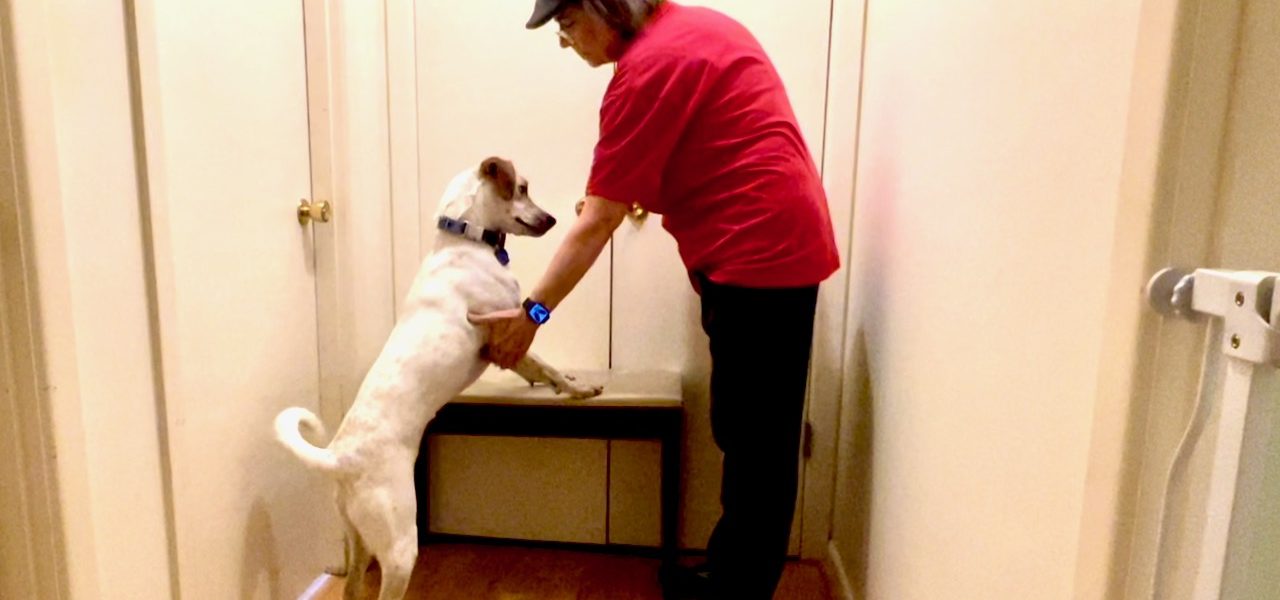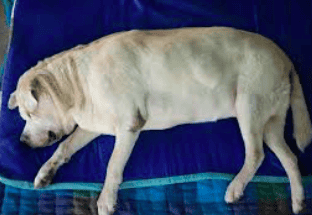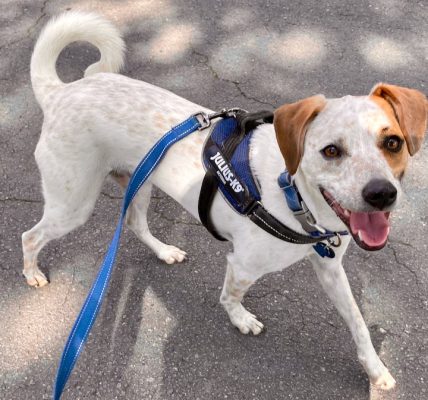I remember how magical it was, the first time I saw someone’s dog come running and happily thrust their head into their harness, then stand still for the buckling up. I was astonished that a dog could learn to do that. Yeah, it was a long time ago.
Since then, I’ve taught a good handful of dogs to be happy with wearing a harness and to help me put it on them. This includes a couple of challenging dogs who were worried at first about wearing gear.
This post doesn’t include instructions for teaching a dog to have their harness put on. Here is a great video by Emily Larlham that delineates those steps. My post deals with some specific difficulties with an overexcited dog.
Clara pops her head through the harness and stands still while I clip straps, or lifts her front foot as needed for her older Hurtta harness. (Her movement helps me remember how to put that harness on—it’s one of those tricky ones.)
Choo Choo, my partner’s chihuahua mix (one of the tough ones to start out with), stands quietly on her hind legs with her front feet on my knees as I sit in a chair and put on the harness. I thank her every time for saving my back. Of course, they all get a treat after this cooperation or even after each step, not to mention an outing.
Lewis sprints around the room, with the chihuahua chasing him and fake snapping at him, then guarding the recliner where he’s headed. He finds a path and leaps wildly over the other dogs onto the recliner, stands there on the top of it, taps his feet, then paws and scratches at me several times in excitement as I put the harness over his head. I have the scars. Then he licks and bumps my face as I lean in to snap the straps.
One of these dogs is not like the others.
Gradual Changes
I read an article this year (2023) on ABA and training that blew my mind. (Thank you, Dr. Christina Alligood, for the great “How Research Works” course.)
The article was “Gradual Change Procedures in Behavior Analysis” by Dr. Stephanie Kincaide. The whole paper is available at the URL.
The focus of the article was that in good teaching and training, we often set up or reinforce gradual changes in all three parts of the three-term contingency: in antecedents, behaviors, and consequences.
In antecedents, we may fade in a stimulus. You see this in desensitization plans, but also in the original protocols of errorless learning. We may do this when the stimulus in its most intense form induces fear in the animal. Or, as in the example I’ll describe here, when the stimulus already has a strong reinforcement history for a different behavior from the one we currently want.
I’ll leave out how the gradual changes concept applies to behaviors and consequences for now (you should read the article!), but may write about it in the future.
I have two main purposes in writing this post. One is to discuss how reinforcement history can prevent a dog from changing a behavior as quickly as we think they should. The other is how I used gradual changes in antecedents to change the ultimate behavior.
The Behavior and My Plan to Change It
When I take Lewis somewhere, for a walk or a ride in the car, I first put his harness on. For two years now, I have cued him to jump onto a recliner so I won’t have to bend over to put on the harness. It also (mostly) prevents me from getting clocked in the jaw if he jumps in excitement. He gets all the way up on the back of the recliner, not in the seat.
But there is a different hazard when he’s up there. When Lewis is excited, he paws. And paws, and paws. He came to me with this behavior installed and fluent. He particularly paws at doors—crate doors, gates, glass doors—you name it.
I’m not a door, but that behavior has generalized. He paws in any exciting scenario. And his target is often me. As I lean in with the harness, I am likely to get scratched.
I guessed that the pawing would decrease if he did a “paws up” behavior rather than standing on all four feet on the chair. It takes more effort to swipe a front paw around while standing on hind legs and balancing with one front one. He also wouldn’t be right in my face.
SPOILER: I guessed wrong. The pawing survived the new position, though diminished. I’m going to continue to describe my process because we succeeded anyway.
I planned to work on a front paw target if the paws up behavior didn’t significantly reduce the pawing on its own.
The Antecedents: What Set Up the Behavior
The immediate antecedents that predict harness application and an outing are:
- the time of day.
- Eileen picking up the harness and leash.
- Eileen approaching the recliner.
- Eileen encouraging Lewis verbally and with a gesture to get up on the chair (not usually necessary). He usually bounds onto the chair before I even get there. Have I mentioned lately that I’m not so great at stimulus control?
- Eileen moving toward him with the harness in “please stick your head in it” configuration.
A couple of other details: The recliner itself is a cue for jumping up at any time of day. And the harness approaching his head has become a cue for pawing at yours truly.
I needed to change the picture.
Bullet Dodges: Reinforcement History
Here’s where, just a few years ago, I would have messed up. But I managed not to this time.
He has a lengthy reinforcement history for jumping up on that recliner to get his harness on. But that’s the place where I wanted him to do paws up instead. I needed him to put two feet on the chair rather than four.
It sounds like such a simple change, but it was not. Did I start my training there, with that particular chair, to teach the new behavior? Nooooo. And did I try to teach the behavior just before taking him for a walk? Nooooo.
In the past, I would have done both. I would have gone to the recliner and cued a paws up behavior and watched, dismayed, as he hopped all the way onto the chair. I would have immediately gotten frustrated. He can already do paws up on cue on several objects. You know that thing where you think your dog “knows it”? He usually doesn’t. In Lewis’ case, the huge reinforcement history for jumping all the way onto the chair would overwhelm his ability to stand on the floor and do paws up there. He would bounce up and down from the chair to the floor like a ping pong ball, missing that in-between behavior of paws up.
See, I’m learning. I knew I was up against the Matching Law. On one side of the scale were the 700+ times Lewis had jumped to the top of the recliner for his harness (and another 1000+ times to watch squirrels out the window). I’m not exaggerating either of those numbers. On the other side was his cued paws up behavior, maybe practiced 100 times, and never on the recliner.
Likewise, I knew trying to teach it immediately before his daily walk was not a good idea. He is way too excited then. That’s part of the problem! I taught his previous “getting my harness on” behavior with all that excitement and movement built in.
I needed to start by eliminating as many of the former antecedents as I could, then reintroduce them, connected with the new behavior. I could change two components immediately: the item we used for paws up (the recliner) and the time of day. We practiced paws up with quiet feet with objects other than the recliner, and we practiced in the morning, when walks were unlikely. The other immediate antecedent was me walking to Lewis holding the harness. I left out this part for a good while and practiced paws up without that complication.
So here is the order in which I faded in parts of the original setting. This is the “gradual changes in antecedents” part.
Fading in the Physical Antecedents
First location: end of a hallway, mostly because it was good for filming.
Order of objects I used for “paws up”:
- a piano bench
Second location: foyer at the front of the house, where the textured tile floor gives dog paws a better purchase.
- the piano bench again
- a sturdy cardboard box with a heavy object inside
- an overstuffed chair
Third location: computer/storage room
- a small wooden chair
Fourth and final location: the den where I normally put his harness on
the sofa where he hangs out a lotthe recliner, where I have been putting his harness on
More about those strikethroughs below.
If this seems like a ridiculous number of steps, recall all those times he jumped up on the recliner in the den in a state of high excitement to get harnessed up. I couldn’t undo that overnight.
The piano bench was a good height and a nice neutral object he had never interacted with. Still, I’ve taught him a lot of jumping onto or into objects. So the first thing he did when we approached the bench was to jump up on it with all four feet before I even caught up with him. But I was able to slow him down, and with the aid of a hand target, show him what I wanted instead.
I practiced treating in position, to give some love for that position, then sometimes switched to marking then tossing a treat on the floor and setting up for another repetition. I would not always be treating in position during the behavior when putting the harness on.
- I worked up some duration.
- I started touching his head and under his front legs while he was in the paws up position.
- I fiddled with his collar and worked up to taking it off and putting it on.
- I brought the harness in and practiced the stages of putting it on him.
During all these steps, I did my best to hold to my criterion of quiet, still front feet, firmly placed on the object.
Bringing in the harness required some backtracking. The harness itself was a cue to “jump up on the thing,” not to mention “scratch Eileen.” So we had to practice quiet paws up in the presence of the harness many times.
I did all these steps on our very first object, the piano bench. Then on the box, and on the overstuffed chair. That one was a challenge since it resembled the recliner more than the first two. It’s also much lower than the first two objects and practically invites a dog to jump on it. I got a fair amount of ping-ponging before I got those back feet on the floor and front feet quiet on the chair, but we got there.
I aimed for a reduced error method using positive reinforcement. Negative punishment would have been easy to include as part of the plan. Since the harness predicts going for a walk, and we were aiming for that big terminal reinforcement in addition to food reinforcers, removing the harness and moving away if he pawed could have punished the pawing behavior. But I did my best to work slowly enough that I pulled the harness away contingent on pawing only a handful of times, perhaps four times in a couple of hundred reps. You’ll see most of them in the movie, in the section where I first introduce his harness. I don’t like using any punishment, and I have used less and less of this variety as I have gotten better at planning my training.
Front Paw Target
Since his swiping at me survived the paws up position, I also started working on a front paw target on a much lower object. I’ve been planning to work on that anyway. I put a clip of that at the end of the video and you can see how much steadier he was with it than with the paws up on higher objects. Looking back, I think it would have been a better place to start than paws up, keeping gradual changes and also muscle fatigue in mind.
Video Showing Part of the Progression
My sloppiness as a trainer is on full display here. I use two different markers for the same thing and two different release cues, I drop treats, I mark and reinforce a paw swipe (see the very beginning of the movie), and I have a devil of a time making criteria decisions on the fly about his busy feet. I’m not proud of any of this. I point it out because I hope it can show how well dogs can often learn despite us, and to give beginners some hope.
Defining criteria is always hard for me, even if I plan it in advance, as I tried to here. How much incidental paw movement is OK? He doesn’t have to be a statue, after all. What about the little adjustments he makes as he gets into position, or the way he stomps his right front foot down? I was likely too tolerant. Allowing some movement was fine for this application since the goal was to do something other than raising his foot into the air and pawing me. But with future paw targets, I will want truly quiet feet.
Unexpected Generalization
All during this process, Lewis was still going on a daily walk, so we were using the old method of him jumping onto the recliner and me protecting myself while putting on his harness.
Imagine my surprise when he stopped swiping me.
I tried, way too late in the game, to get some “before” footage. And failed repeatedly.
This was not according to plan. There he was, every day, standing for the harness, then sitting while I fastened the straps. He was not pawing at me as I installed his harness. I tried a different harness to check—yep, no paw swipes for that one, either.
I Dared to Change the Plan
Practicing quiet feet outside the context of the exciting walk was apparently a winning strategy. So winning that I reverted to Lewis’ original position on top of the recliner now that he could stand and sit still. That’s a more comfortable position for me to work with anyway: no bending over.
But I see a bullet to dodge here, too. I will not quit practicing. It would be a bad mistake to assume the behavior is “fixed” forever. I’m going to continue working on the “quiet front feet” behavior in the many contexts, including transferring it to a “portable” flat target. I have other situations with the need for quiet feet.
If his new behavior stays steady in the harness situation, this will be my last post on the topic. If I have misjudged and we get busy feet again, I’ll report our next steps.
I may also create a shorter and less technical version of this post for dog guardians who are not interested in the theory part, but could benefit from the gradual changes outlined. I know this post is awfully long!
Related Posts
Copyright 2023 Eileen Anderson












